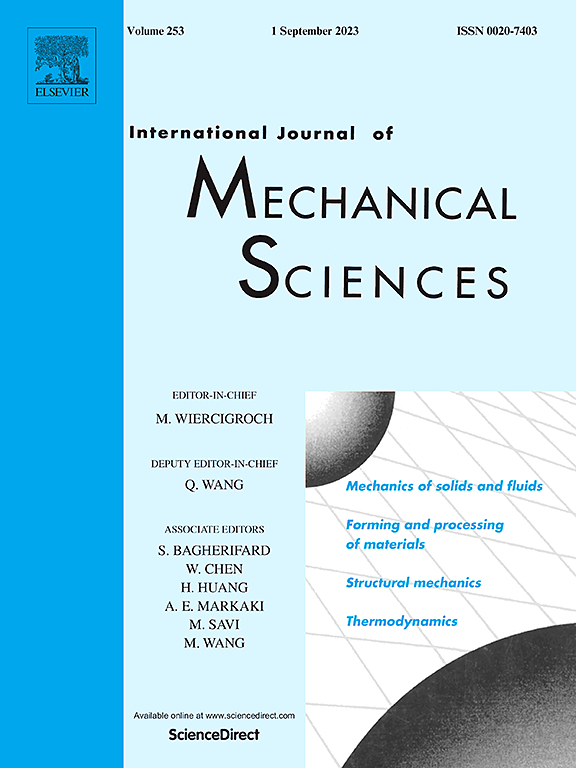纵向波导混合元结构的创新分层设计
IF 7.1
1区 工程技术
Q1 ENGINEERING, MECHANICAL
International Journal of Mechanical Sciences
Pub Date : 2025-02-01
DOI:10.1016/j.ijmecsci.2025.109963
引用次数: 0
摘要
本研究介绍了一种功能波导的分层设计方法,利用具有逐步几何变化的二维蜂窝作为基本微结构,重点研究了冲击载荷下时域响应的可调性。通过保持恒定的均质密度,我们的方法可以操纵沿波传播路径的刚度。半经验模型,基于曲线拟合的有限元解,准确地预测动态响应,包括波的传播速度,力传递到支撑和反射速度在尖端。利用Ashby图,我们开发了一种模块化策略来组装波导束-甚至束束-以满足特定的性能标准,提高设计效率。该框架非常适合与机器学习和多目标优化相结合,可以为航空航天、汽车和生物医学领域的冲击保护和智能驱动等应用提供量身定制的设计,标志着动态环境材料设计的重大进步。本文章由计算机程序翻译,如有差异,请以英文原文为准。

An innovative hierarchical design of hybrid meta-structures for longitudinal waveguides
This study introduces a hierarchical design methodology for functional waveguides, utilizing 2D honeycombs with stepwise geometric variations as foundational microstructures, focusing on the tunability of time-domain responses under impact loads. By maintaining constant homogenized density, our approach manipulates stiffness along the wave propagation path. A semi-empirical model, based on curve-fitting to finite element solutions, accurately predicts dynamic responses including wave propagation speed, force transmission to supports, and reflected velocities at the tip. Using Ashby plots, we develop a modular strategy for assembling waveguide bundles – or even bundles of bundles – to meet specific performance criteria, enhancing design efficiency. This framework, ideal for integrating with machine learning and multi-objective optimization, enables tailored designs for applications ranging from impact protection to smart actuation in aerospace, automotive, and biomedical sectors, marking significant advancements in material design for dynamic environments.
求助全文
通过发布文献求助,成功后即可免费获取论文全文。
去求助
来源期刊

International Journal of Mechanical Sciences
工程技术-工程:机械
CiteScore
12.80
自引率
17.80%
发文量
769
审稿时长
19 days
期刊介绍:
The International Journal of Mechanical Sciences (IJMS) serves as a global platform for the publication and dissemination of original research that contributes to a deeper scientific understanding of the fundamental disciplines within mechanical, civil, and material engineering.
The primary focus of IJMS is to showcase innovative and ground-breaking work that utilizes analytical and computational modeling techniques, such as Finite Element Method (FEM), Boundary Element Method (BEM), and mesh-free methods, among others. These modeling methods are applied to diverse fields including rigid-body mechanics (e.g., dynamics, vibration, stability), structural mechanics, metal forming, advanced materials (e.g., metals, composites, cellular, smart) behavior and applications, impact mechanics, strain localization, and other nonlinear effects (e.g., large deflections, plasticity, fracture).
Additionally, IJMS covers the realms of fluid mechanics (both external and internal flows), tribology, thermodynamics, and materials processing. These subjects collectively form the core of the journal's content.
In summary, IJMS provides a prestigious platform for researchers to present their original contributions, shedding light on analytical and computational modeling methods in various areas of mechanical engineering, as well as exploring the behavior and application of advanced materials, fluid mechanics, thermodynamics, and materials processing.
 求助内容:
求助内容: 应助结果提醒方式:
应助结果提醒方式:


